7M2 Global Studies
Section outline
-
Welcome to our MHJC Online 7M2 Global Studies 2020 course page.
Please do not hesitate to contact me at mmartin@mhjc.school.nz if you have any questions about your classwork or homework. I look forward to working with you all in 2020.
Ms Martin
-
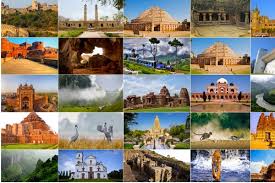
Learning Intention:
What is a World Heritage site, why are they selected, and what can I and my community do to help preserve heritage sites in my community and globally?
Success Criteria:
Identify the concept of World Heritage regarding natural and cultural sites.
Identify the criteria required for designation on as World Heritage siteDescribe key concepts related to this context
Describe some of the World Heritage sitesExplain examples and determine the appropriateness of the site for World Heritage designation.
List evidence to support arguments in supporting or opposing designation on of example sites as World Heritage sites.Evaluate the concept of World Heritage regarding natural and cultural sites on Achievement Objectives
L3 Understand how people view and use places differently
Class code FOR GOOGLE CLASSROOM 7jmschH
ACTIVITIES1. Starter game country
http://www.sheppardsoftware.com/Geography.htm
2. Treasure of the world
3. Which country I am?
4. Your hiding country
5. Heritage brainstorm
-
This term we will have an exciting time in Global Studies, the general learning we will achieve is an understanding of the meaning of Heritage, through comparing and contrasting countries around the world. The learning will be the focus on different people, food, artefacts, traditions, holidays from other countries, examples of customs of people in the past.
For the exploring stage, we will start by identifying the 7 continents of the world, major countries and oceans on a world mapBig Idea: Treasures of the world
Learning Intentions: We are learning to (WALT)...
Understand the meaning of culture
Identify groups of people who live in other countries
Identify food from other countries
Identify family traditions and holidays from other countries
Provide examples of traditions and customs from people in the past
Identify the 7 continents, major countries of the unit and oceans on a world map
Understand differences in cultures
Achievement Objectives:
1. Understand how people pass on and sustain culture and heritage for different reasons and that this has consequences for people.
2. Understand that events have causes and effects.
Success Criteria: I can/have...
- I can locate at least 10 countries in a world blank map
- I can explain what is culture
- I can identify some differences between some chosen countries
Activities:
1. World map blank: fill up the map with countries (5 minutes looking at the globe)
EXPLORE / TŪHURA learning intentions:
- We are EXPLORING What a World Heritage site is
- Taonga sites globally around the world.
- We are EXPLORING how the world heritage world sites are selected
- We are EXPLORING how to preserve these special sites
EXPLORE / TŪHURA learning intentions:
- We are EXPLORING What a World Heritage site is
- Taonga sites globally around the world.
- We are EXPLORING how the world heritage world sites are selected
- We are EXPLORING how to preserve these special sites
-
Learning Intention:
What is a World Heritage site, why are they selected, and what can I and my community do to help preserve heritage sites in my community and globally?
Success Criteria:
Identify the concept of World Heritage regarding natural and cultural sites.
Identify the criteria required for designation on as World Heritage site
Identify and locate natural and cultural World Heritage sitesDescribe key concepts related to this context
Describe some of the World Heritage sitesExplain examples and determine the appropriateness of the site for World Heritage designation.
List evidence to support arguments in supporting or opposing designation on of example sites as World Heritage sites.
Use geographical questions to investigate a World Heritage siteEvaluate the concept of World Heritage regarding natural and cultural sites on
Explain the importance of World Heritage listingActivitiesAchievement Objectives
L3 Understand how people view and use places differently
Understand how people pass on and sustain culture and heritage for different reasons and that this has consequences for people.
Understand that events have causes and effects.
1. Treasures of the world
2. Key terms- Definition map
3. Reasons for visiting particular places.
4. Brainstorm HeritageEXPLORE / TŪHURA learning intentions:
- We are EXPLORING What a World Heritage site is
- Taonga sites globally around the world.
- We are EXPLORING how the world heritage world sites are selected
- We are EXPLORING how to preserve these special sites
-
Enjoy Camp guys!!!!
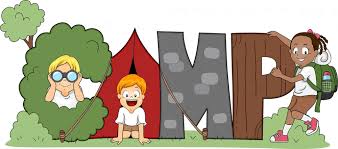
EXPLORE / TŪHURA learning intentions:
- We are EXPLORING What a World Heritage site is
- Taonga sites globally around the world.
- We are EXPLORING how the world heritage world sites are selected
- We are EXPLORING how to preserve these special sites
-
Learning Intention:
What is a World Heritage site, why are they selected, and what can I and my community do to help preserve heritage sites in my community and globally?
Success Criteria:
Identify the concept of World Heritage regarding natural and cultural sites.
Identify the criteria required for designation on as World Heritage site
Identify and locate natural and cultural World Heritage sitesDescribe key concepts related to this context
Describe some of the World Heritage sitesExplain examples and determine the appropriateness of the site for World Heritage designation.
List evidence to support arguments in supporting or opposing designation on of example sites as World Heritage sites.
Use geographical questions to investigate a World Heritage siteEvaluate the concept of World Heritage regarding natural and cultural sites on
Explain the importance of World Heritage listingACTIVITIESThis week we are FOCUSSING in the meaning of WHS for different groups of people and the variety of THREATS for this world heritage sites.
Achievement Objectives
L3 Understand how people view and use places differently
Understand how people pass on and sustain culture and heritage for different reasons and that this has consequences for people.
Understand that events have causes and effects.
1. Guess the threat
2. Analysis of photos with a description of threats
FOCUS / ARONGA learning intentions:
- We are FOCUSING on the meaning of WHS for different groups of people
- We are FOCUSING on the variety of THREATS for this world heritage sites.
- We are FOCUSING on ways to preserve these Taonga on the world
-
- Assessment Time:
The following task will make up your assessment for this term. You are to read through the task again after your teacher introduces it and read through the rubric to understand what is required
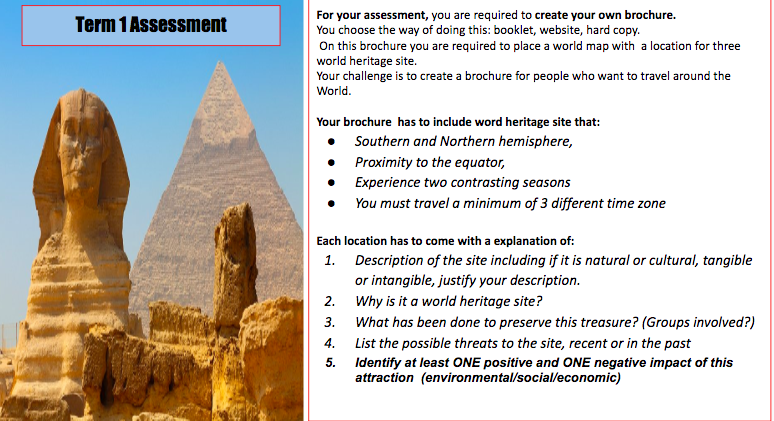
Before you begin your final assessment it is a good idea to investigate what terms such as tangible, natural, cultural, intangible mean as this is important to understand your final assessment.
We are learning to
- Recognise that different websites use more than one click to find information
- Use one website but click on multiple tags to find extra information
To Do
- Use the link below to find the following information
- https://whc.unesco.org/en/list/
Look at the list of countries and decide on three world heritage sites to create your travel brochure from.
Now follow the steps.
- Write the three world heritage sites into your global studies book
- Beside each site list whether it is in the southern or northern hemisphere
- Beside each site, list which country it is in.
- Describe whether it is a natural or cultural site
Example:
Statue of Liberty:
- Northern Hemisphere,
- United States of America,
- Cultural site

- Take a screen shot of the heritage site on a map (use the map tab on the UNESCO website to help you to help you find this.
- Finally..... use the description tab and the video tab to read and listen about the site. In your own words write a description of the sight.
Complete these steps with the other two sites you have chosen.
- Assessment Time:
-
7M2 GLOBAL STUDIES ASSESSMENT 1: TREASURES OF THE WORLD
PLEASE UPLOAD YOUR FIRST ASSESSMENT USING THE LINK BELOW
-
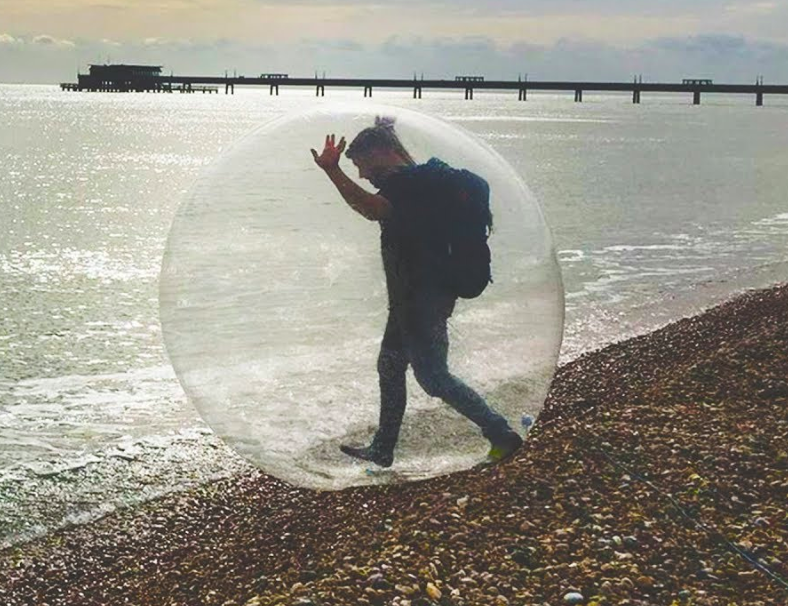
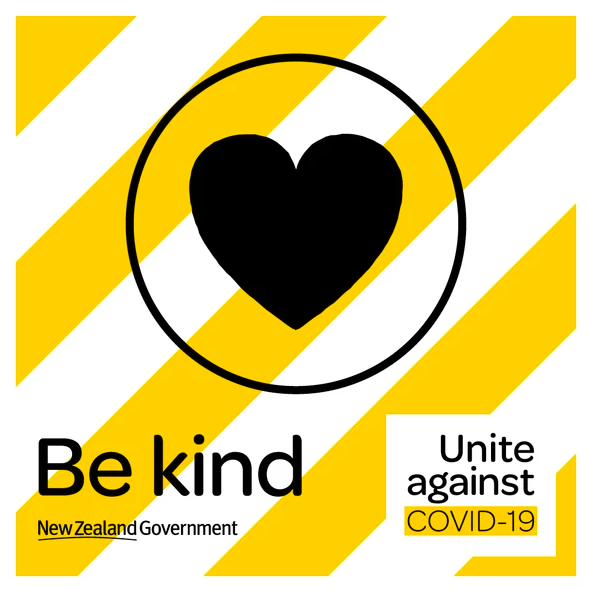
Hello class, for this first week of learning from home you have three expectations from me which are basically tidying up our tasks left from term 1.
I have posted in Google classroom the activities and the resources:
1. FINISH THE ASSESSMENT AND UPLOAD IT
2. FINISH THE BOOKLET OF THE WORLD HERITAGES SITES OF THE WOLRD
3. DO THE ACTIVITIES FROM SLIDE 12 OF THE SLIDE SHOW
Remember that we will be meeting every THURSDAY AT 9:00AM
-

We will be continuing our work on the Taonga of the world
Success Criteria: I can/have...
Identify the resources of a geographical area
Research how the resource is perceived, used and protected
Explain how these ideas determine the decisions made about the resources
Learning Intention
We are EXPLORING the world treasures in resources using geographic and mapping skills.
We are focusing on developing the use of map skills
Visible Learning
identifying continents and countries on a map and locate the local area through the development of map skills.
describe the location of the local area using simple geographical terms
Develop skills to use a map and Atlas effectively to locate features
Provide a 4 and 6 figure reference to locate places in a map
ACTIVITIES IN GOOGLE CLASSROOM
1. QUIZ
World Heritage Sites Quiz, Part 1
2.FUN MAPPING -
Over the next few weeks, you will be working from home, please include your family and do the activities together if you are able. I know that your family are busy people, but working together in your bubble is a good way to keep connected - perhaps you can include elder family members too - a phone call to an aunt or a grandparent to share what you are learning could even surprise you with what your family already know!
Our new learning context is Wai and Kai not. Can you guess what this might be about? Wai is Māori for water and Kai is food - so how do these words go together? What might the not mean?
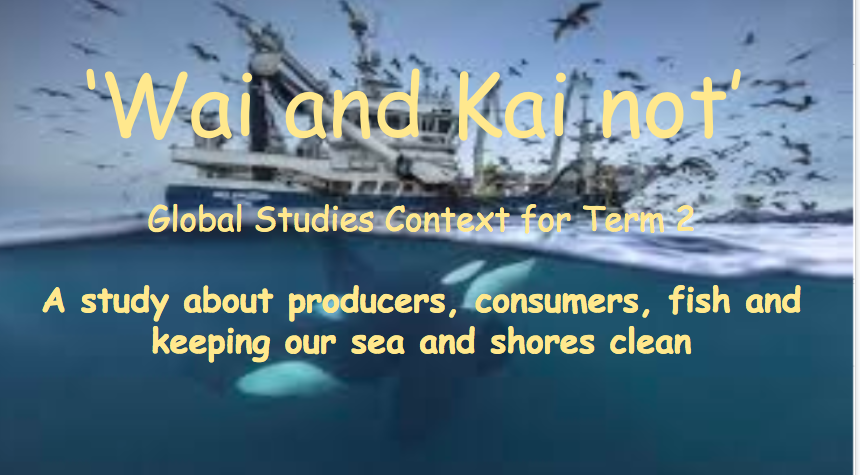
We are going to start investigating the consumer world and its impact on us, on our whanau, in our country and on our world.
Our goal will be to discover how we can be better consumers so we limit our impact on the environment.

This week we will look at needs and wants through different activities including drawing and playing cards. Have your needs and wants changed over the past 4 weeks?
Achievement Objectives:
L4: Understand how producers and consumers exercise their rights and meet their responsibilities.
L4: Understand how formal and informal groups make decisions that impact on communities.
Learning Intentions: I can/have...
- have a "big picture" of what the new topic for term 2 means
- understand the relationship between Rights and Responsibilities
- identify the difference between a want and a need.
- contribute ideas through different activities
Success criteria: I can/have...
- explain what the expectations for Term 2 are
- understand the importance of being responsible in order to respect people's rights
- give a definition of what Needs and Wants are
- make a collage showing needs and wants
Activities: (Google classroom)
- Read the Outline for Term 2
- Rights/Responsibilities
- Needs/Wants
-
EXPLORE / TŪHURA learning intentions:
- We are EXPLORING what are rights and responsibilities are and connecting these to our identity as consumers
- We are EXPLORING wants and needs and classifying these into essential and non-essential. We are collaborating with others to develop of shared understanding
Achievement Objectives:
Understand how producers and consumers exercise their rights and meet their responsibilities.
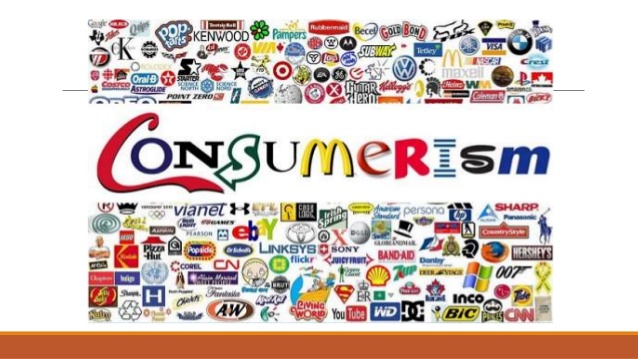
With our new context you will be working with your bubble, and by yourself investigating the consumer world and its impact on us, on our Whanau. Our goal will be how we can better consumers so we can limit the impact on our environment.
This week we will look at needs and wants through different activities including, drawing and playing cards.
Learning Intentions: We are learning to (WALT)...
- understand the relationship between Rights and Responsibilities
- identify the difference between a want and a need.
- contribute ideas through the different activities
Success Criteria: I can/have...
- understand the importance of being responsible in order to respect people rights
- give a definition of what is Needs and Wants
- make a collage showing wants and needs.
Rights/Responsibilities Google classroom
Wai Kai not- Slide 9 and 10.
-
Kia ora. Welcome to another week of distance learning. Have you been keeping up with the news? I guess we will know early in the week whether we this will be our last week working at a distance.
Achievement Objectives
Understand how producers and consumers exercise their rights and meet their responsibilities.
Learning outcomes:
Students will explore consumer protection in an authentic context.
Key concepts:
Rights
Responsibilities
Laws and regulations
Consumer protection
Success criteria: I can/have...
- Both consumers and retailers have rights and responsibilities
- Consumer protection laws and regulations cover goods and services purchased in New Zealand.
Activities (Google classroom):
- Why we buy
- Watch End of the line Video
- Consumer Rights (for early finishers)
Homework:
EXPLORE / TŪHURA learning intentions:
- We are EXPLORING what are rights and responsibilities are and connecting these to our identity as consumers
- We are EXPLORING wants and needs and classifying these into essential and non-essential. We are collaborating with others to develop of shared understanding
-
Global Studies Learning Intention
We are EXPLORING what are rights and responsibilities are and connecting these to our identity as consumers
We are EXPLORING wants and needs and classifying these into essential and non-essential. We are collaborating with others to develop of shared understanding
Global Success Criteria
Identifying key concepts
Observing the importance of being responsible in order to respect people rights
Identifying and describing the rights and responsibilities of consumers and producers
Define overfishing
Identify the ways by which overfishing can be mitigated
making connections between the process of trash disposal from our house to the ocean
Describe some environmental problems created by our consumer world
categorising impacts in the water due to our consumerism
Describe the problems overfishing creates
describe the process of extraction through sale, use and disposal, all the stuff in our lives affects communities at home and abroad
Describe how the Consumer Guarantees Act and the Fair Trading Act protect the consumer
making connections between the process of trash disposal from our house to the ocean
Delineate why overfishing has occurredReflecting future economic and environmental strategies
ACHIEVEMENT OBJECTIVES:
Understand how producers and consumers exercise their rights and meet their responsibilities.
Our goal will be to discover how we can be better consumers so we limit our impact on the environment.
ACTIVITIES: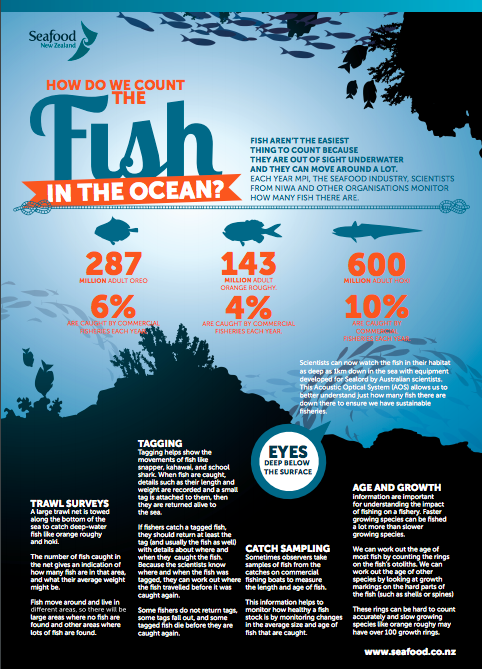
END OF THE LINE-TAKING NOTES- ANSWER QUESTIONS
SO FAR:
1. KEY CONCEPTS- WAI AND KAI SLIDES
2. NEEDS/WANTS
3. GOODS/SERVICES
4. RIGHTS AND RESPONSIBILITIES
5. WHY WE BUY?
-
Kia ora. Did you get out on the water during the long weekend? Perhaps you went fishing? If you could give some advice to recreational fishers what would it be? What about commercial fishers? Wai or Kai not?
Success Criteria: I can/have...
- Both consumers and retailers have rights and responsibilities
- Consumer protection laws and regulations cover goods and services purchased in New Zealand.
Achievement Objectives
Understand how producers and consumers exercise their rights and meet their responsibilities.
Learning outcomes:
Students will explore consumer protection in an authentic context.
Key concepts:- Rights
- Responsibilities
- Laws and regulation
- Consumer protection
Studies Learning Intention
We are EXPLORING what are rights and responsibilities are and connecting these to our identity as consumers
We are EXPLORING wants and needs and classifying these into essential and non-essential. We are collaborating with others to develop of shared understanding
Global Success Criteria
Identifying key concepts
Observing the importance of being responsible in order to respect people rights
Identifying and describing the rights and responsibilities of consumers and producers
making connections between the process of trash disposal from our house to the ocean
Describe some environmental problems created by our consumer world
categorising impacts in the water due to our consumerism
describe the process of extraction through sale, use and disposal, all the stuff in our lives affects communities at home and abroad
Describe how the Consumer Guarantees Act and the Fair Trading Act protect the consumer
making connections between the process of trash disposal from our house to the ocean
Reflecting future economic and environmental strategies
FOCUS / ARONGA learning intentions:
- We are Focusing on how our choices as consumers are creating the problem of overfishing
- We are FOCUSING on ways by which overfishing can be mitigated
FOCUS / ARONGA learning intentions:
- We are Focusing on how our choices as consumers are creating the problem of overfishing
- We are FOCUSING on ways by which overfishing can be mitigated
- We are FOCUSING in Hauraki Gulf's fish stocks in decline
-
We are learning to
- use sketch notes to create a brainstorm page of main facts.
After practising with the overfishing sketch note for overfishing, have a go at using the following facts in a sketch note page.
Make sure you use different symbols , different fonts for key phrases and words. Use all of the page for your facts. Use the information below to create a page about the negative impacts of aquiculture.
Topic: AQUICULTURE: THE NEGATIVE IMPACTS
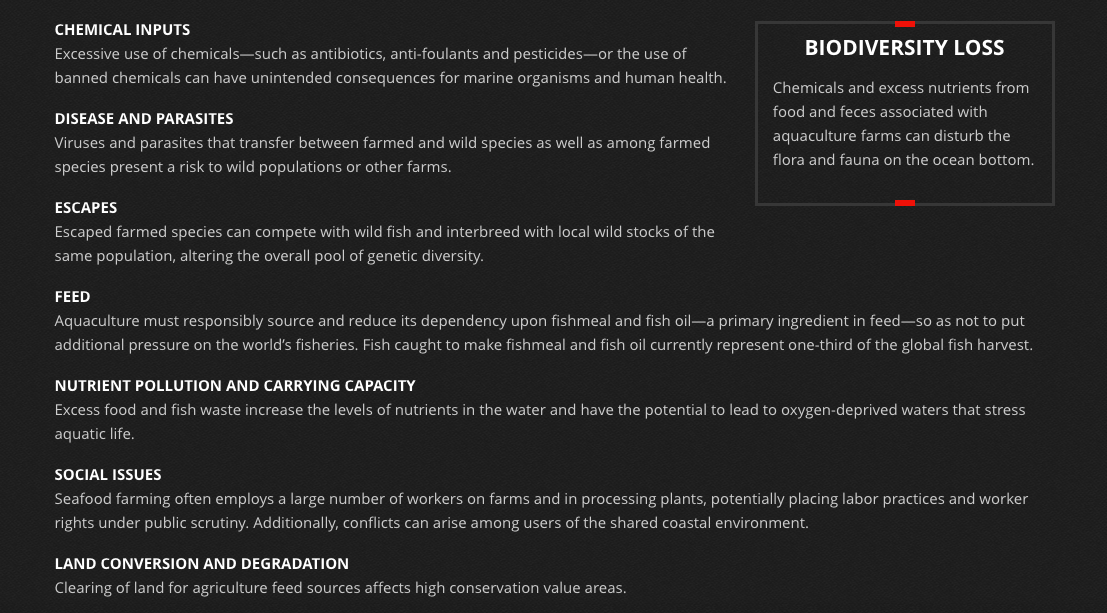
-
Year 7 Global and Science Assessment - Presentation
You will deliver an oral presentation, (this could live or prerecorded) that explains the issue your static image addresses
Your oral presentation must include:
What the problem is and why this reflects the needs and wants of consumers and rights and responsibilities of producers.
The current legislation as it applies to New Zealand
The impact of commercial fishing on the environment and society of New Zealand
Specifically mention how food webs are disrupted using an example of a New Zealand aquatic animal (fish)
Advice for consumers when purchasing fish and/or for recreational fishers
Your TED talk should reflect the scientific and legal terms, language and concepts we have covered in class. Your TED talk will refer to your static image and explain the visual elements you have used to support your ideas.
-
This week you will be finishing your script for your Ted Talk.
The presentations will happen Week 11 on Thursday 25th June
You will deliver an oral presentation, (this could live or prerecorded) that explains the issue your static image addresses
Your oral presentation must include:
What the problem is and why this reflects the needs and wants of consumers and rights and responsibilities of producers.
The current legislation as it applies to New Zealand
The impact of commercial fishing on the environment and society of New Zealand
Specifically mention how food webs are disrupted using an example of a New Zealand aquatic animal (fish)
Advice for consumers when purchasing fish and/or for recreational fishers
Your TED talk should reflect the scientific and legal terms, language and concepts we have covered in class. Your TED talk will refer to your static image and explain the visual elements you have used to support your ideas.
-
This week we will do the TED TALKS WITH MISS HUNTER
-
Kua takoto te Mānuka.
The leaves of the Manuka tree have been laid down (a challenge has been laid down or there is a challenge ahead of you).
Kia ora. I really enjoyed listening to your TED Talk presentations last week. This week, we are going to continue our exploration of consumer rights in New Zealand.
Success Criteria: I can/have...
- Both consumers and retailers have rights and responsibilities
- Consumer protection laws and regulations cover goods and services purchased in New Zealand.
Achievement Objectives
Understand how producers and consumers exercise their rights and meet their responsibilities.
Learning outcomes:
Students will explore consumer protection in an authentic context.
Key concepts:- Rights
- Responsibilities
- Laws and regulation
- Consumer protection
Studies Learning Intention
We are EXPLORING what are rights and responsibilities are and connecting these to our identity as consumers
We are EXPLORING wants and needs and classifying these into essential and non-essential. We are collaborating with others to develop of shared understanding
Global Success Criteria
Identifying key concepts
Observing the importance of being responsible in order to respect people rights
Identifying and describing the rights and responsibilities of consumers and producers
making connections between the process of trash disposal from our house to the ocean
Describe some environmental problems created by our consumer world
categorising impacts in the water due to our consumerism
describe the process of extraction through sale, use and disposal, all the stuff in our lives affects communities at home and abroad
Describe how the Consumer Guarantees Act and the Fair Trading Act protect the consumer
making connections between the process of trash disposal from our house to the ocean
Reflecting future economic and environmental strategies
Activities:
- Watch the video for Consumer Rights -
- Complete activities on google classroom
Homework:
-
Achievement Objective (Level 4)
Understand how exploration and innovation create opportunities and challenges for people, places, and environments.
To DO: Use the following website
https://nzhistory.govt.nz/culture/encounters
Explore the web to find information on Captain James Cook and create an informative document about him. Use the following questions to help your 'fact finding mission' but see if you can add lots of other interesting facts about him
Which country has he born in?
What was his main job before sailing to NZ?
What year did he begin exploring in NZ and where did he travel to?
What do you think some of the challenges were that he faced while exploring?
What information did you find to describe the type of environment they were exploring?
Add a map of where they explored and a picture of him if you can find one.
Abel Tasman
James Cook
Donald Sutherland
Charles Heaphy
Thomas Brunner
Kehu
Marion du Fresne
Jean François Marie de Surville
Owen F. Smith
Samuel Marsden
Henry Williams
William Colenso
Bishop George Selwyn
Frederick Tuckett’s
TJohn Turnball Thompson
Patrick Caples
Ernst Dieffenbach
Julius von Haast
Ferdinand von Hochstetter
Andreas Reischek
Fedrick Carrington
Joseph Thomas
John Rochford
William Mein Smith
Stephenson Percy Smith
William Fox
Edward and Arthur Dobson
James Mackay
James Hector
Arthur Paul Harper
Joseph Banks
Dr Daniel Solander
EXPLORE / TŪHURA learning intentions:
- We are EXPLORING...who discovered New Zealand by researching the history of explorers to NZ and collecting key information about them
- We are EXPLORING how early settlers in NZ discovered places by investigating different resources to find the information we need to learn about the challenges and opportunities that faced these explorers
- We are EXPLORING the great walks of NZ by researching about the opportunities that tourism can benefit from by marketing these experiences.
-
Achievement Objective (Level 4)
Understand how exploration and innovation create opportunities and challenges for people, places, and environments.
To DO: Use the following website
https://nzhistory.govt.nz/culture/encounters
Explore the web to find information on Captain James Cook and create an informative document about him. Use the following questions to help your 'fact finding mission' but see if you can add lots of other interesting facts about him
Which country he born in?
What was his main main job before sailing to NZ?
What year did he begin exploring in NZ and where did he travel to?
What do you think some of the challenges were that he faced while exploring?
What information did you find to describe the type of environment they were exploring?
Add a map of where they explored and a picture of him if you can find one.
See if you can add another 4 or 5 interesting facts about his life. Get creative with your presentation and then upload onto the assignment space in google classrooms.
EXPLORE / TŪHURA learning intentions:
- We are EXPLORING...who discovered New Zealand by researching the history of explorers to NZ and collecting key information about them
- We are EXPLORING how early settlers in NZ discovered places by investigating different resources to find the information we need to learn about the challenges and opportunities that faced these explorers
- We are EXPLORING the great walks of NZ by researching about the opportunities that tourism can benefit from by marketing these experiences.
-

Who found what in NZ?
Before we go and see what explorers found where, I think it is important that we do a little bit of getting to know what NZ looks like and where some of the main places in the country are.
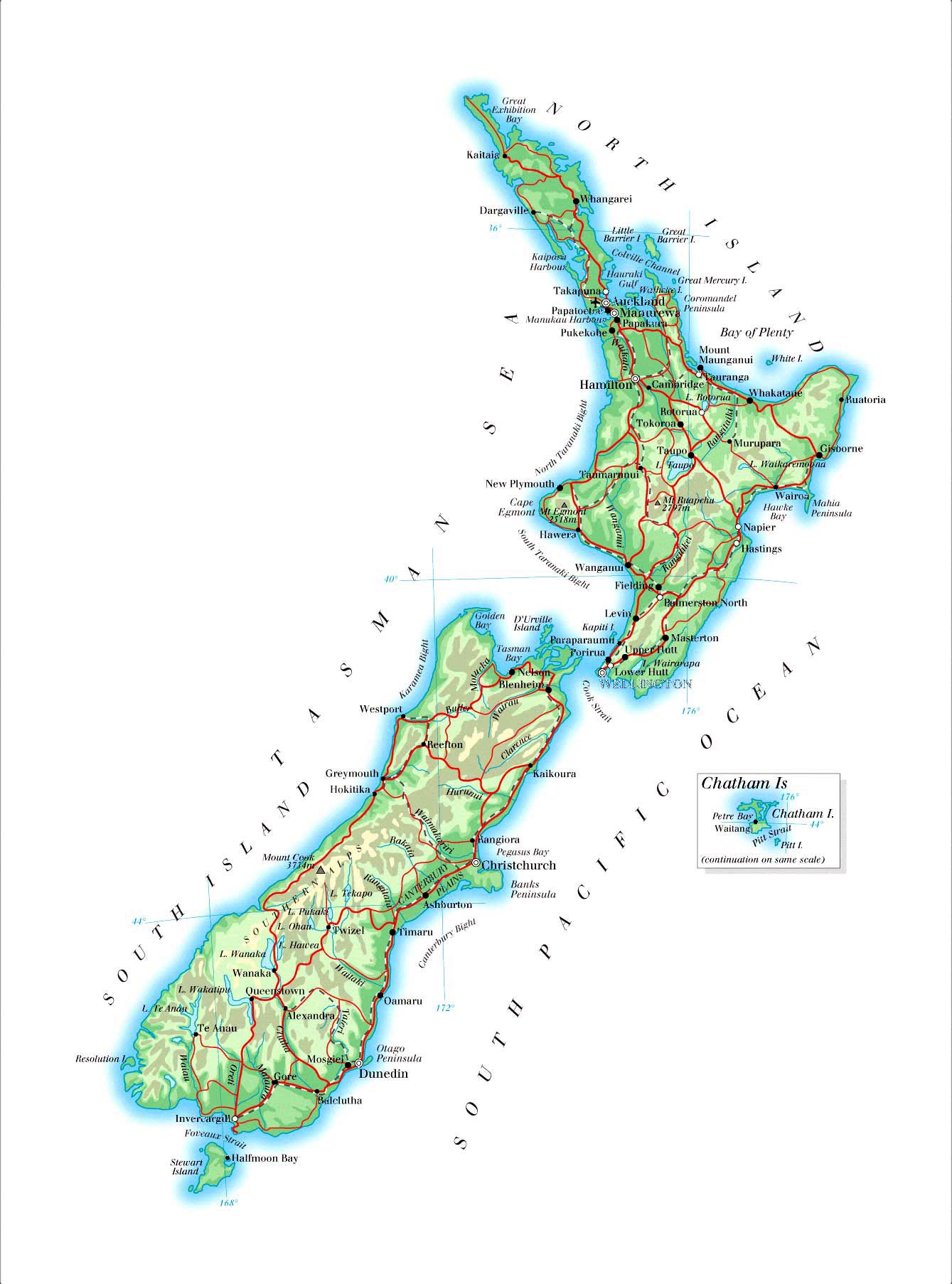
To Do:
Glue these two maps into your global studies book and use the detailed map to find the following places: Use a dot to pinpoint the place and then use a ruler to draw a lone out so that you can label the place.
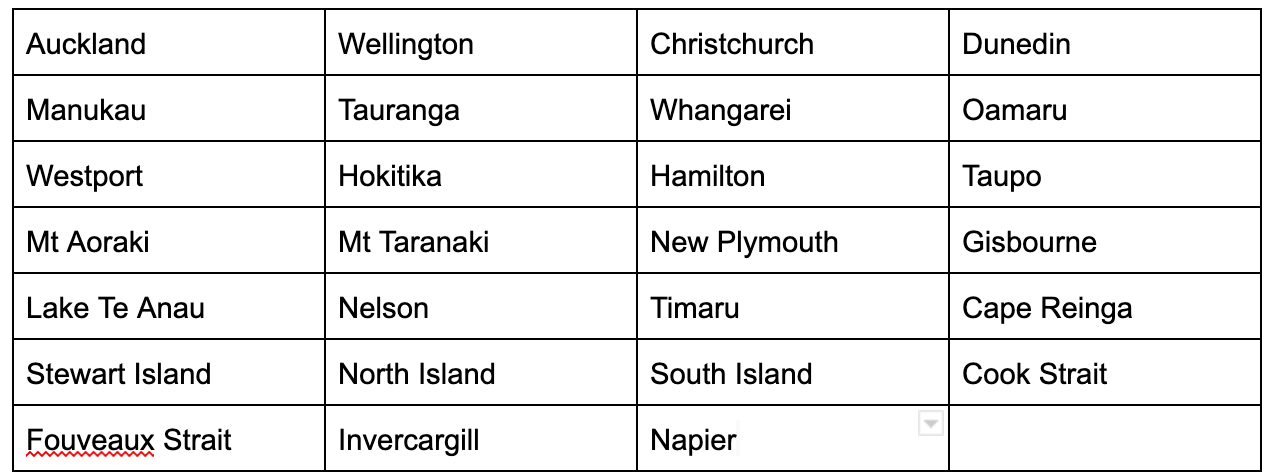
Learning Intention:
We are learning to retrieve information from a variety of sources.
To do: The following websites will help you find information on most of the explorers in the table below. Choose one explorer and answer the following questions about their life and times. If you can't find any information then you will have to type in to google or another search engine some questions about the person you have chosen.
https://natlib.govt.nz/schools/topics/5946ee01fb002c5cf101563bAbel Tasman
Donald Sutherland
Charles Heaphy
Thomas Brunner
Kehu
Jean Francois
Owen F Smith
Samuel Marsden
Henry Williams
William Colenso
Bishop George Selwyn
Federick Tuckett
John F Turnball
Patrick Caples
Ernst Dieffenback
Julius Von Haast
Ferdinand von Hochstetter
Andreas Reischek
Fedrick Carrington
Joseph Thomas
John Rochford
William Mein Smith
Stephenson Percy Smith
William Fox
Edward and Arthur Dobson
James Mackay
James Hector
Arthur Paul harper
Nathaniel Chalmers
Joseph Banks
Dr Daniel Solander
Edmund Hillary
Captain James Herd
-
We are learning to create a' kahoots' based around the knowledge of Captain Cook.
You have been doing some reading and research about Captain Cook. If you have finished your stop animation of his discovery of NZ now have a go at setting up a Kahoots challenge for the rest of the class.
Here are the steps you need to follow and the questions you need to make up answers for are listed below.
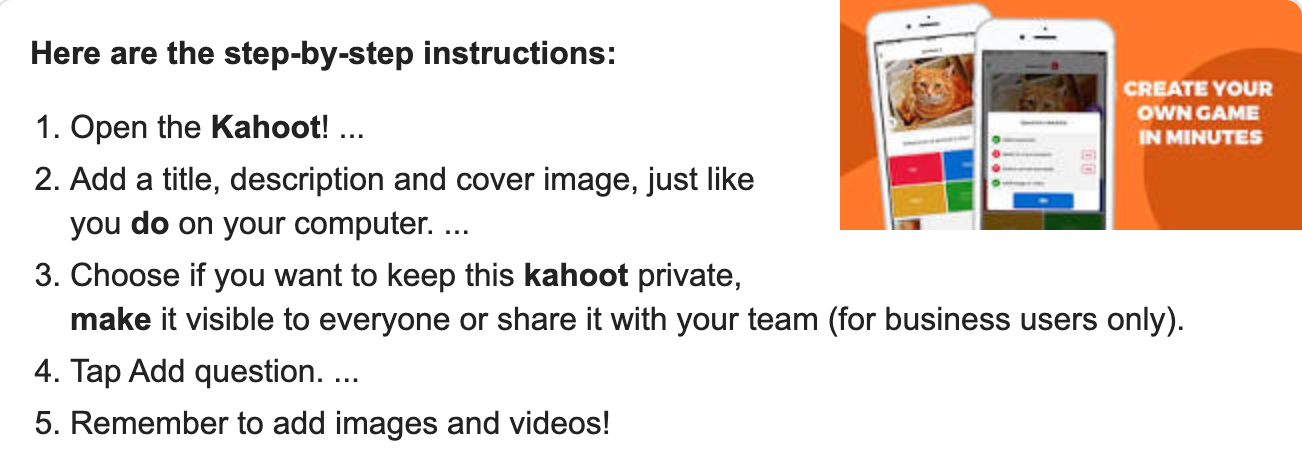
What year was Captain Cook born?
What was his early job before he began sailing around the world exploring?
What was the name of the ship he sailed on when he discovered NZ?
What type of Captain of a ship did his crew see him as?
Why did he travel to Tahiti?
What was his real mission from the British government to try and achieve?
What is scurvy?
What part of NZ did he first land at?
What did he need to make his communication with the local Maori work smoothly?
What was one of the main challenges he faces in NZ?
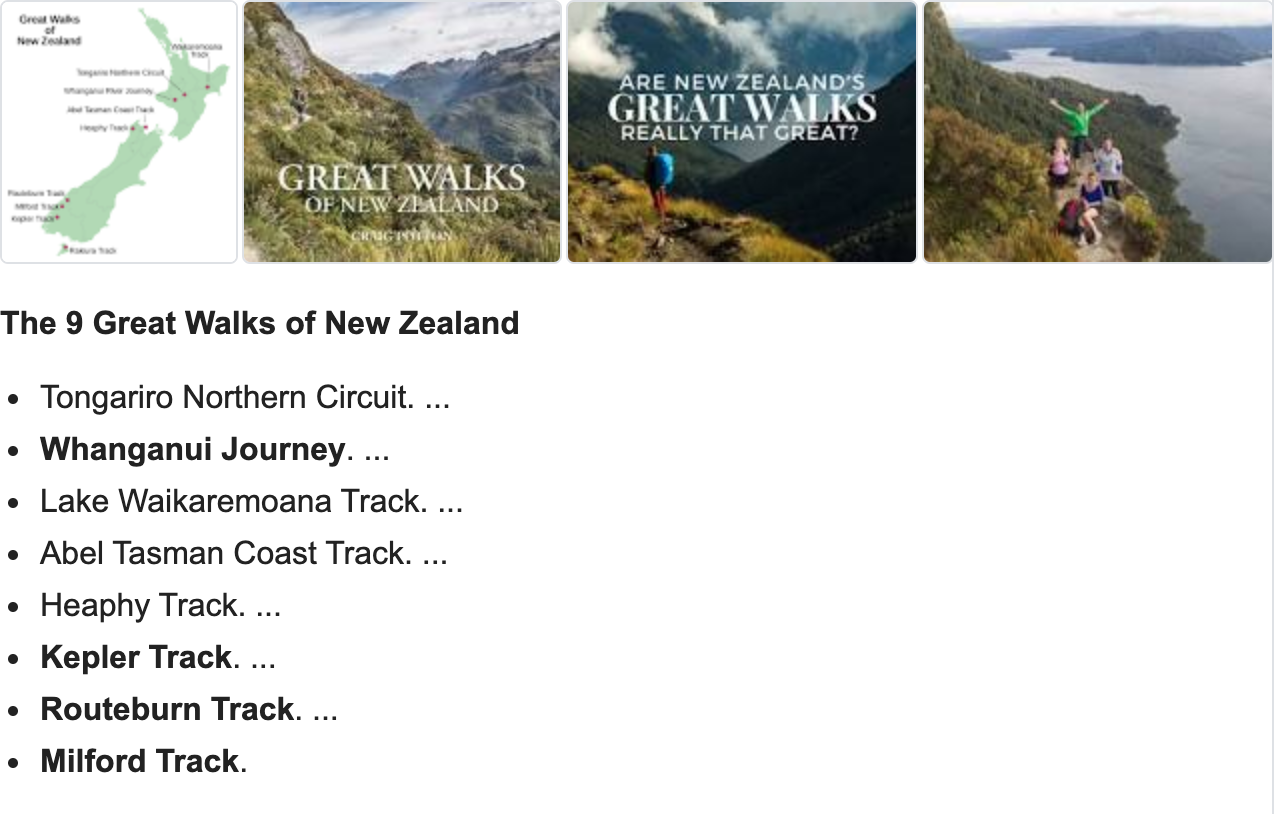
FOCUS / ARONGA learning intentions:
- We are FOCUSING...to identify the important facts of Captain James Cook's exploration of nZ and explainthe challenges and opportunities he faced
- We are FOCUSING...on transforming our knowledge of Captain Cook's arrival to NZ to a stop animation video to explain the main points
PLAN & DO / WHAKAMAHI learning intentions:
- We are PLANNING... to prepare a google slide show that highlights the great walks of NZ so that we can...share our findings with others in the class
- We are planning to create a stop annimation video which demonstrates the arrival of Captain James Cook to the shores of NZ so that we can present our research in an innovative way
-

REFLECT / WHAIWHAKAARO learning intentions:
- We are REFLECTING...on the challenges and opportunities created for people who discovered and maintained the great walks of NZ by reviewing the walks and what they have to offer.
-
Welcome back to our last term of the year. For this one, we will look at the cultural nature of scientific research. How people interpret science in different ways based on their social environments.
Science is a collaborative effort among all of the different cultures and countries of the world.
Big Idea: To infinity and Beyond
Learning Intentions: We are learning to (WALT)..
- Explore famous scientists, their theories, places of origin, and their culture
- Document scientific viewpoints of famous scientists throughout history
- Know about some of the major discoveries in astronomy and space exploration
- Understand how these were made
- Be able to put these in order and explain the reasons for this
- Discuss geographical region, culture, gender, and other factors affecting scientific theories and discoveries
Achievement Objectives:
- Understand how exploration and innovation create opportunities and challenges for people, places, and environments.
Success Criteria: I can/have...
- Identify the main explorers of the universe in history
- completed the Explore the Famous Scientists
- described the beginning of the wondering of the universe and why
Activities:
- https://www.nationalgeographic.com/science/space/universe/origins-of-the-universe/
- https://www.youtube.com/watch?v=epuoIYqIkBc
While you are watching the video, think about the processes of scientific inquiry and the nature of science
Use the handout, Famous Scientists and work in groups.
Place the scientists on the world map.
Discuss how science is an accumulated contribution of different scientists coming from different cultures throughout many periods.
- Images of Albert Einstein, Carolyn Shoemaker, and Abd AlRahman Al Sufi can be found at the following websites:
- Einstein: http://albert-einstein.org/
- Shoemaker: http://www.universetoday.com/html/articles/2001-1211a.html
- Sufi: http://www.sfusd.k12.ca.us/schwww/sch618/ScienceMath/Science2.html
Homework:
Complete a report of a scientist from your selection.https://www.youtube.com/watch?v=wNDGgL73ihY
EXPLORE / TŪHURA learning intentions:
- We are EXPLORING... the cultural nature of scientific research. The students will understand
- We are EXPLORING... how people interpret science in different ways based on their social environments.
-
Big Idea: To infinity and Beyond
Learning Intentions: We are learning to (WALT)..
- Explore famous scientists, their theories, places of origin, and their culture
- Document scientific viewpoints of famous scientists throughout history
- Know about some of the major discoveries in astronomy and space exploration
- Understand how these were made
- Be able to put these in order and explain the reasons for this
- Discuss geographical region, culture, gender, and other factors affecting scientific theories and discoveries
Achievement Objectives:
- Understand how exploration and innovation create opportunities and challenges for people, places, and environments.
Success Criteria: I can/have...
- Identify the main explorers of the universe in history
- completed the Explore the Famous Scientists
- described the beginning of the wondering of the universe and why
Activities:
- https://www.nationalgeographic.com/science/space/universe/origins-of-the-universe/
- https://www.youtube.com/watch?v=epuoIYqIkBc
While you are watching the video, think about the processes of scientific inquiry and the nature of science
Use the handout, Famous Scientists and work in groups.
Place the scientists on the world map.
Discuss how science is an accumulated contribution of different scientists coming from different cultures throughout many periods.
- Images of Albert Einstein, Carolyn Shoemaker, and Abd AlRahman Al Sufi can be found at the following websites:
- Einstein: http://albert-einstein.org/
- Shoemaker: http://www.universetoday.com/html/articles/2001-1211a.html
- Sufi: http://www.sfusd.k12.ca.us/schwww/sch618/ScienceMath/Science2.html
Homework:
Complete a report of a scientist from your selection.https://www.youtube.com/watch?v=wNDGgL73ihY
EXPLORE / TŪHURA learning intentions:
- We are EXPLORING... the cultural nature of scientific research. The students will understand
- We are EXPLORING... how people interpret science in different ways based on their social environments.
-
Achievement Objectives:
- Understand how exploration and innovation create opportunities and challenges for people, places, and environments.
Success Criteria: I can/have...
- Identify the main explorers of the universe in history
- completed the Explore the Famous Scientists
- described the beginning of the wondering of the universe and why
Activities:
Famous Astronomers, This week is a short week due the long weekend, on Thursday we will finish the Famous Astronomers Presentations.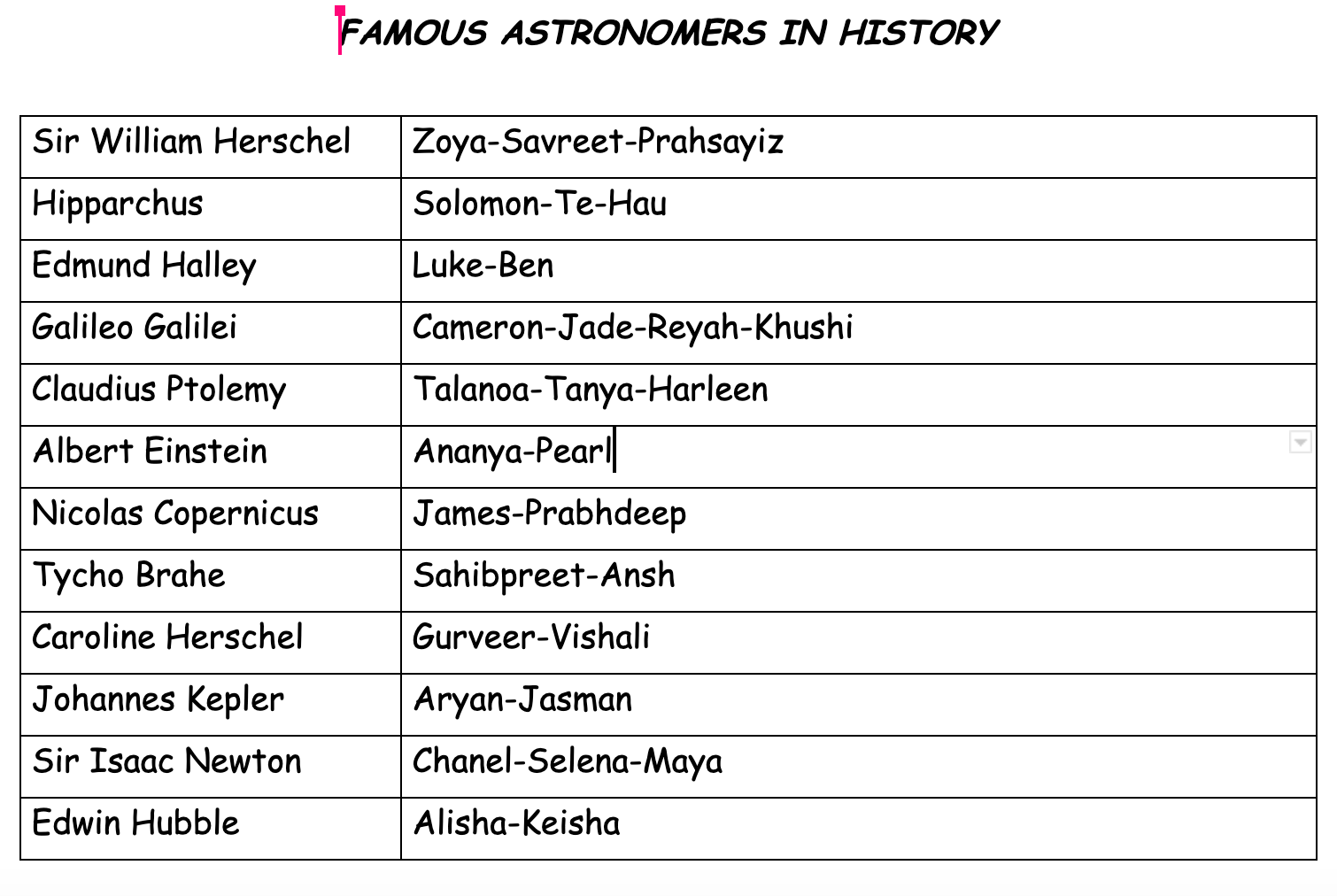
-
We are continuing this week finishing our posters for the Famous Astronomers
Learning Intention: We are learning to find relevant information from a variety of texts and present it in our own words to create an informative poster.
Task:
Famous Astronomer Assignment
You have been introduced to a number of famous astronomers and scientists from history. These people have made huge discoveries about the planet and universe we live in. Your mission is to choose one person from the list and design an informative poster. It should tell the audience reading it that the following information
What Discovery did that person make?
What were the most important years of their work and findings and what were they?
What culture-historical era was that person from?
Why were they curious?
Why is it important about the thing they discovered?
What were the challenges they faced?
Add a timeline to your poster of the important findings of this scientist/astronomer
EXPLORE / TŪHURA learning intentions:
- We are EXPLORING... the cultural nature of scientific research. The students will understand
- We are EXPLORING... how people interpret science in different ways based on their social environments.
-
Big Idea: Far and Beyond
Learning Intentions: We are learning to (WALT)...
- Explore famous scientists, their theories, places of origin, and their culture
- Document scientific viewpoints of famous scientists throughout history
- Discuss geographical region, culture, gender, and other factors affecting scientific theories and discoveries
Achievement Objectives:
- Understand how exploration and innovation create opportunities and challenges for people, places, and environments.
Success Criteria: I can/have...
- Identify the main explorers of the universe in history
- list some interesting facts about the history of the exploration of the universe
- named different cultures involved in the study of the universe
Activities:
Write a brief report about a famous scientist in history, that has contributed to the exploration of our universe. This poster must address the following:
- The scientists’ major findings and discoveries, in your own words.
- How did these findings impact the world and the people living during that time? Has that knowledge changed or evolved in our current society?
- The country they are from as well as,
- The time period they lived in- describe anything relevant about that time period with regards to major events and culture.
- Finally, finish with a SEXY paragraph that justifies and explains why we are studying these scientists, and how it relates to understanding our context overall.
EXPLORE / TŪHURA learning intentions:
- We are EXPLORING... the cultural nature of scientific research. The students will understand
- We are EXPLORING... how people interpret science in different ways based on their social environments.
-

Satellite Web Hunt
INSTRUCTIONS- work in pairs.
1. Take a look at the link to GeoEye-1 Satellite images, and by scrolling through these images, come up with a list of potential uses for satellites and satellite imagery.
2. Based on this brainstorm, why do you think that Satellites are important to our world today? How do we use satellites?
3. Find one image that you find particularly interesting, and give 1 real world example of how it might provide you with useful or important information.
4. Read the article Artificial Satellites and use the internet to answer the folowing:
What size are the smallest artificial satellites?
What is the largest artificial satellites?
Find images of both of these satellites
5. How many satellites are in the global positioning system (GPS) constellation?
What type of orbit do they occupy?
Find a image showing the GPS satellite constellation.
6. What type of orbit does the Hubble Space Telescope occupy?
How was it launched into orbit?
Find two images taken from the Hubble Space Telescope.
7. Find a satellite image that appeals to you. If possible, print a colour copy of the image as a reminder that, without satellites, our modern world would be severely disadvantaged.
http://www.satimagingcorp.com/gallery/geoeye-1/
http://sciencelearn.org.nz/Contexts/Satellites/Science-Ideas-and-Concepts/Artificial-satellites
EXPLORE / TŪHURA learning intentions:
- We are EXPLORING... the cultural nature of scientific research. The students will understand
- We are EXPLORING... how people interpret science in different ways based on their social environments.
